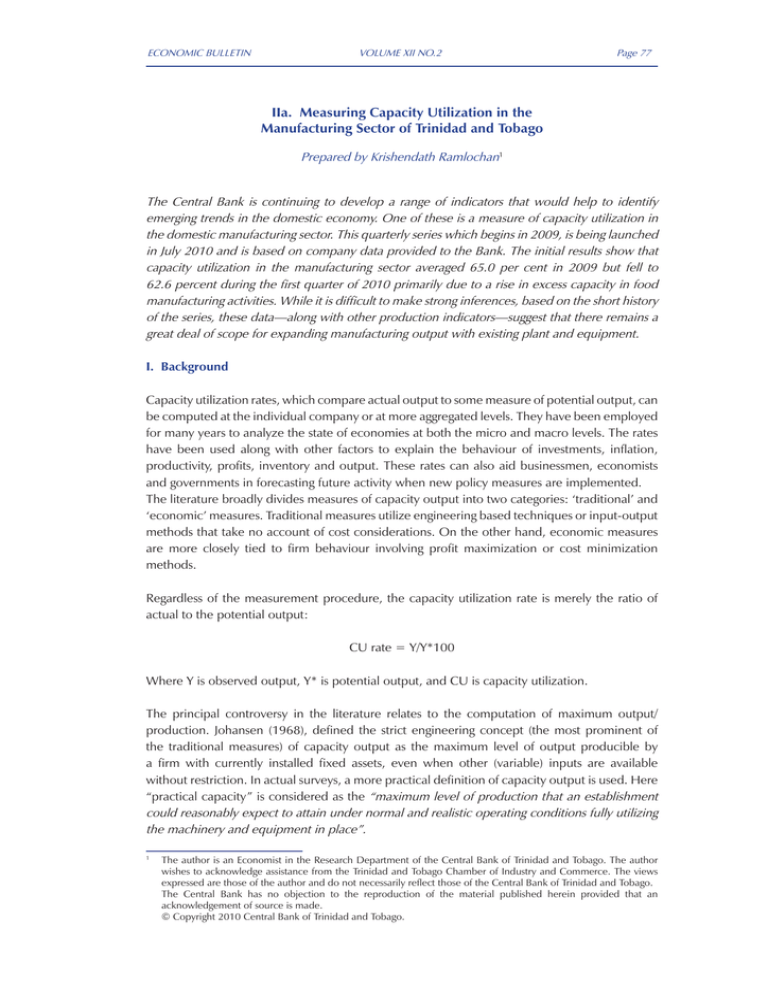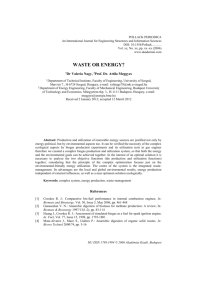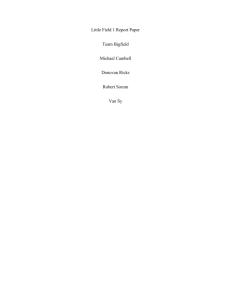IIa. Measuring Capacity Utilization in the
advertisement

ECONOMIC BULLETIN VOLUME XII NO.2 Page 77 IIa. Measuring Capacity Utilization in the Manufacturing Sector of Trinidad and Tobago Prepared by Krishendath Ramlochan1 The Central Bank is continuing to develop a range of indicators that would help to identify emerging trends in the domestic economy. One of these is a measure of capacity utilization in the domestic manufacturing sector. This quarterly series which begins in 2009, is being launched in July 2010 and is based on company data provided to the Bank. The initial results show that capacity utilization in the manufacturing sector averaged 65.0 per cent in 2009 but fell to 62.6 percent during the first quarter of 2010 primarily due to a rise in excess capacity in food manufacturing activities. While it is difficult to make strong inferences, based on the short history of the series, these data—along with other production indicators—suggest that there remains a great deal of scope for expanding manufacturing output with existing plant and equipment. I. Background Capacity utilization rates, which compare actual output to some measure of potential output, can be computed at the individual company or at more aggregated levels. They have been employed for many years to analyze the state of economies at both the micro and macro levels. The rates have been used along with other factors to explain the behaviour of investments, inflation, productivity, profits, inventory and output. These rates can also aid businessmen, economists and governments in forecasting future activity when new policy measures are implemented. The literature broadly divides measures of capacity output into two categories: ‘traditional’ and ‘economic’ measures. Traditional measures utilize engineering based techniques or input-output methods that take no account of cost considerations. On the other hand, economic measures are more closely tied to firm behaviour involving profit maximization or cost minimization methods. Regardless of the measurement procedure, the capacity utilization rate is merely the ratio of actual to the potential output: CU rate = Y/Y*100 Where Y is observed output, Y* is potential output, and CU is capacity utilization. The principal controversy in the literature relates to the computation of maximum output/ production. Johansen (1968), defined the strict engineering concept (the most prominent of the traditional measures) of capacity output as the maximum level of output producible by a firm with currently installed fixed assets, even when other (variable) inputs are available without restriction. In actual surveys, a more practical definition of capacity output is used. Here “practical capacity” is considered as the “maximum level of production that an establishment could reasonably expect to attain under normal and realistic operating conditions fully utilizing the machinery and equipment in place”. 1 The author is an Economist in the Research Department of the Central Bank of Trinidad and Tobago. The author wishes to acknowledge assistance from the Trinidad and Tobago Chamber of Industry and Commerce. The views expressed are those of the author and do not necessarily reflect those of the Central Bank of Trinidad and Tobago. The Central Bank has no objection to the reproduction of the material published herein provided that an acknowledgement of source is made. © Copyright 2010 Central Bank of Trinidad and Tobago. ECONOMIC BULLETIN VOLUME XII NO.2 Page 78 It should be noted that the traditional capacity measures have been criticized on the following grounds:2 • Although capacity utilization indices based on production and engineering data are widely used, they are subject to ambiguous interpretations and suspect economic foundations; and • Traditional engineering measures ignore limitations in the supply of inputs which may affect the ability of firms to reach certain levels of outputs. In response to the difficulties with the engineering measure of capacity output, several authors including Cassels (1937) and Klein (1960), have promoted an economic concept3 which incorporates cost minimization or profit maximization behaviour. The economic measure4 of capacity output is defined as the production level at the minimum point of the short run average cost (SRAC) curve. This is shown on Figure 1 below: Figure 1: Capacity Output Under the Economic Concept Cost MC SRAC C* MR1 Qu Q* Q1 MR2 Output Optimal output, Qu, is determined by the short-run profit maximization point where marginal revenue (MR) equals short-run marginal cost (SRMC). Capacity output Q* is the level of output at which short-run average cost function is at a minimum. Actual production (profit maximizing level of output), Qu, is less than capacity output yielding a capacity utilization rate less than unity. This may occur as a consequence of low demand or inventory buildup as part of a firm’s internal strategy. In some cases, increased demand can lead to increased output near to capacity or even beyond capacity output. For example, in temporary peak periods, an expansion in demand leads to a shift in the marginal revenue curve outwards from MR1 to MR2. This leads to a profit maximizing level of output Q1 which exceeds capacity output Q*, thereby generating a capacity utilization rate exceeding unity. In practice, the engineering method is utilized in most countries (including the United States and Canada). Despite its weak economic-theoretic foundation, the literature does provide some support for its use. According to Doyle (2000), studies by Schnader (1984) and Christiano (1981), suggest that survey respondents tend to use some version of practical capacity since the economic definition involves estimating cost functions which requires more information 2 3 4 See for example Azeez (2002), Garofalo and Malhotra (1997), and Gajanan and Malhotra (2007). The economic capacity concept dates back to Cassel’s paper in 1937. See Klein, (1960); Berndt and Morrison, (1981); Morrison, (1985). ECONOMIC BULLETIN VOLUME XII NO.2 Page 79 than a business actually has. Forest (1979) also pointed out that in any event the definition of practical capacity really combines both the engineering and economic concepts—in essence, the engineering measure of maximum production (which directs the respondent to compute capacity considering a “realistic work schedule”) introduces economic considerations. Based on these factors, the first phase of this analysis involves use of the engineering method.5 II. Calculation Methodology and the Quarterly Survey of Domestic Production The Central Bank of Trinidad and Tobago routinely conducts a Quarterly Survey of Domestic Production for the purpose of compiling its Quarterly Index of Gross Domestic Product. In the first quarter of 2009, a modified survey was distributed to the Manufacturing sector requesting additional information; maximum production (see Box 1 for the definition of maximum production in the Survey), employment, hours worked capacity changes and capacity constraints. Box 1 Definition of Maximum Production in the Quarterly Survey of Domestic Production Maximum production - maximum level of output producible by a firm with currently installed fixed assets, even when other (variable) inputs are available without any restriction. Computation of this maximum level of production is based on the following assumptions: • Only the machinery and equipment in place and ready to operate will be utilized. • Labor, materials, utilities, etc. are fully available. • The number of shifts, hours of plant operations, and overtime pay that can be sustained under normal conditions and a realistic work schedule. For the purpose of the current exercise, capacity utilization rates are computed at the product, firm and sub-sector levels as well as for the overall manufacturing sector. Capacity utilization rates for each firm are computed using the formula: Ci = Υi / Υ * *100 where: Yi Y* Ci = actual production = maximum production of firm i, = capacity utilization rate for firm i. The manufacturing sector is sub-divided into seven sub-sectors in accordance with the Trinidad and Tobago System of National Accounts (TTSNA). These sub-sectors are Food, Drink and Tobacco (FDT), Chemicals & Non-Metallic Minerals (CNM), Assembly Type & Related Industries (ARI), Printing, Publishing, Etc (PPE), Textiles, Garment & Footwear (TGF), Wood & Related Products (WRP) and Miscellaneous Manufacturing Industries (MMI). The rates at the firm level are aggregated to derive the capacity utilization rates at the sub-sector level using the relevant weights6. 5 6 Extensions to the economic methodology will be undertaken when adequate cost and profit information from firms are available. The weights used reflect firms’ contribution to Manufacturing real value added in the base year (2000). ECONOMIC BULLETIN VOLUME XII NO.2 Page 80 The sub-sectors’ weights7 are presented in Table 1 below: Table 1 This table indicates that the FDT, CNM and the ARI sub-sectors, which accounted for 76.7 per cent of manufacturing value added in the year 2000, dominate economic activity in the Manufacturing sector. The sub-sectoral weighting formula for the capacity utilization rate of the overall Manufacturing sector is represented as follows: 7 CUmanuf = ∑W C i =1 i i 7 ∑W i =1 Where: i Wi = Weight for sub-sector i. Ci = Capacity utilization rate for sub-sector i. CUmanuf = Capacity utilization rate for the Manufacturing sector. An expansion of this formula yields: CU Manuf = [(C FDT * WFDT ) + (C CNM * WCNM ) + (C ARI * W ARI ) + (C PPE * WPPE ) + (CTGF * WTGF ) + (CWRP * WWRP ) + (C MMI *W MMI )] /(WFDT + WCNM + W ARI + WPPE + WTGF + WWRP + WMMI ) Chart 1 Sub-Sectors Capacity Utilization Rates 7 These weights reflect sub-sectors contribution to Manufacturing real value added in the base year (2000). The weights therefore are not fully representative of the current structure of manufacturing activity and will be updated when the national accounts are rebased. ECONOMIC BULLETIN VOLUME XII NO.2 Page 81 III. Results Computational results for the various Manufacturing sub-sectors8 are presented in Chart 1, while capacity utilization rates for the overall Manufacturing sector are illustrated in Chart 2. Chart 2 Capacity Utilization Rates in the Manufacturing Sector The results in Chart 1 suggest that among the Manufacturing sub-sectors, the FDT sub-sector recorded the highest capacity utilization rates for 2009. Sales data for 2009 suggest that the demand for food products, both domestically and from other Caribbean countries, has been less sensitivity to the economic downturn than other manufacturing activities. More recent data indicate, however, that output of the Food, Drink and Tobacco sub-sector may have slipped in the first quarter of 2010 when compared to the same period of 2009, thereby leading to a reduction in the capacity utilization rate in the Manufacturing sector. For the Manufacturing sector as a whole, the results indicate that capacity utilization rates averaged around 65.0 per cent during 2009. Barring a peak during the fourth quarter of 2009, capacity utilization in the Manufacturing sector has been on a declining trend. The capacity utilization rate for the first quarter of 2010 (62.6 per cent) was 3.9 per cent lower than in the first quarter of 2009 largely on account of reduced production in most sub-sectors, especially the FDT sub-sector. The rates broadly indicate that there is still significant spare capacity in the Manufacturing sector. One implication is that manufacturing output could respond to a recovery in demand without the need in the short run for major investments in new plant and equipment. Indeed, there could also be a substantial lag in manufacturing companies’ having to hire new workers as output goes up. IV. Conclusion The preliminary results indicate that there is still considerable spare capacity in the economy which is undoubtedly related to the economic slowdown. One particular concern facing many countries is how quickly employment responds to an economic recovery. In general, the higher the level of slack capacity in an economy, the longer it takes for employment (and inflation to rise). These notions would be explored further as the data collection process expands. 8 The capacity utilization rates for the overall Manufacturing sector and selected sub-sectors (Food, Drink and Tobacco, Chemicals and Non Metallic Minerals and Assembly Type and Related Industries) will be published in Summary Economic Indicators. ECONOMIC BULLETIN VOLUME XII NO.2 Page 82 REFERENCES Azeez, E. A. 2002. Economic Reforms and Industrial Performance: An Analysis of Capacity Utilization in Indian Manufacturing. M.Phil Diss., Jawaharlal Nehru University, New Delhi, Centre for Development Studies, Trivandrum. Berndt, E. R., and C. J. Morrison. 1981. “Capacity Utilisation Measures: Underlying Economic Theory and Alternative Approach.” American Economic Review, Vol. 71, No.2 (May): 4857. Cassels, J.M. 1937. “Excess Capacity and Monopolistic Competition.” Quarterly Journal of Economics, Vol. 51, No.3 (May): 426-443. Gajanan, S., and D. Malhotra. 2007. “Measures of Capacity Utilization and its Determinants: A Study of Indian Manufacturing.” Applied Economics, Vol. 39, No.6: 765–776. Garofalo, G. and Malhotra, D. 1997. “Regional Measures of Capacity Utilization in the 1980s.” Review of Economics and Statistics, Vol.79, No.3: 415–21. Klein, L.R. 1960. “Some Theoretical Issues in the Measurement of Capacity.” Econometrica, Vol. 28, No.2 (April): 272-286. BIBLIOGRAPHY Berndt, E.R., and D. Hesse. “Measuring and Assessing Capacity Utilisation in the Manufacturing Sectors of Nine OECD Countries.” European Economic Review, Vol. 30, No.5 (1986): 961989. Canada. Statistics Canada. Canadian Industrial Capacity Utilization Rates: A Brief Summary of Methodology. (n.d.). http://www.bankofcanada.ca/en/rates/indinf/product_def_en.html Doyle, Maura p. The 1989 Change in the Definition of Capacity: A Plant- Level Perspective A Plant-Level Perspective. George Washington University, Washington D.C, 2000. Kim, Youn. H. “Economic Capacity Utilization and its Determinants: Theory and Evidence.” Review of Industrial Organization, no.15 (1999): 321-339. Klein, L R, and R.S. Preston. “Some new results in the Measurement of Capacity Utilization.” American Economic Review, Vol.57, No.1 (March 1967): 34-58. Morin, Norman, and J. Stevens. Estimating Capacity Utilization from Survey Data. Division of Research & Statistics and Monetary Affairs, Federal Reserve Board, Washington, D.C, 2004. Morrison, C.J. “Primal and Dual Capacity Utilisation: An Application to Productivity Measurement in the U.S. Automobile Industry.” Journal of Business and Economic Statistics, Vol.3, No.4, (October 1985): 312-324. Morrison, C.J. “On the Economic Interpretation and Measurement of Optimal Capacity Utilization with Anticipatory Expectations.” Review of Economic Studies, Vol.52, No.2 (1985): 295-310. Nelson, Randy A. “On the Measurement of Capacity Utilization.” The Journal of Industrial Economics, Vol. 37, No.1 (1989): 273-286. ECONOMIC BULLETIN VOLUME XII NO.2 Page 83 Phillips, Almarin. “Industrial Capacity: An Appraisal of Measures of Capacity.” American Economic Review, Vol.53, No.2 (1963): 275-292. Segerson, Kathleen., and D. Squires. “On The Measurement of Economic Capacity Utilization for Multi-Product Industries.” Journal of Econometrics, Vol. 44, No.3 (1990) 347-361. United States. U.S. Census Bureau. The Survey of Plant Capacity Utilization. (n.d.). http://www. census.gov/econ/overview/ma0900.html.







